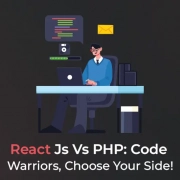Are HTML, CSS, and JavaScript Enough? (Front-end Framework)
Quick Summary: The front end is the presenting layer of your application. It describes all the stuff that users view. Moreover, the front-end framework includes intuitive and pleasant interfaces that efficiently store, present and update data from the backend or API. The initial iteration of the website is constructed using JavaScript, HTML, and CSS. This article will detail the primary technologies used in building an application.
Introduction
I’m afraid I have to disagree with people when they say, “No, you’re limiting yourself to HTML, CSS, and JavaScript” (Front-end Framework) because it does not make sense.
Are you aware of the numerous websites worldwide that developers create using only HTML, CSS, and JavaScript?
With the help of leading Frontend Development Services, Many websites are created without a framework. GitHub and YouTube are probably the most well-known.
Many! Many websites are fundamental, and users pay for them. Why wouldn’t HTML, CSS, and JavaScript be enough for a full-time career if people are willing to pay for them?
Front-End Frameworks: What Are They?

Tools, libraries and components make building complex and standard applications easy. Additionally, they provide other developers with greater abstraction over HTML, CSS, and JavaScript frameworks so they can create apps more quickly and with fewer lines of code.
Moreover, the front-end framework provides a structured development approach and helps build consistent projects. Large teams of developers working on complex applications often use it precisely.
Advantages Of Using Front-End Frameworks

We’ve provided some key recommendations for how a front-end framework could effectively un:
-
Maintainability
The app is divided into reusable, standalone components, enabling swift changes without affecting the entire application.
-
Separation of concerns
Front-end framework designs are maintainable, modular architecture that allows front-end developers to do their best. It takes the data and displays it intuitively to build an app’s user base.
-
Speed
The boilerplate code addresses everyday issues that make it easy to get the app and run on component-based design quickly for development.
-
Collaboration
The same design patterns the frameworks offer make it simple for novice developers to create and maintain projects.
-
Community
Front-end is a popular framework with a large community base that gives dedicated tutorials, forums, meetups and generally supportive developers whose help can be taken.
Do You Require A Front-End Framework For Your Web Application?
Front-end frameworks are not mandatory for every web application. You can effortlessly use only HTML, JavaScript, and CSS technologies to create the front end of a simple online application. This front-end technology stack in web development is adequate for creating a web app with simple dynamic controls that can respond to user queries.
As a result, your web application can function without the use of front-end frameworks. Conversely, its usability, functionality, and upkeep will be severely limited.
For example, you don’t require a front-end framework to create a static web app. JavaScript is essential to create an interactive web application, but employing a front-end framework is not obligatory.
The decision to use a front-end framework for web application development is primarily based on personal preference rather than a strict requirement.
How can HTML and CSS be utilized in combination to craft websites?
HTML is responsible for generating codes for the layout and content of a website. It includes text, images, forms, links, and buttons, all used to create a website’s various components and features. Whereas CSS, on the other hand, is a language that was utilized to design the website. It helps to change the aspects such as size, color, and position of elements listed.
Combining these two languages would give you enough tools to build a one-landing page or business website. However, web development is just more than CSS and HTML. Below, we will explore additional languages and technologies frequently utilized when they are helpful and practicable.
JavaScript
HTML and CSS alone can be significantly limiting to developing an application. Yet, users can achieve website functionality by clicking on bars ranging from small to large. By using JavaScript, the entire front-end behavior changes. JavaScript manipulates the visual elements of a webpage. In addition, it results in a more exciting and elaborate website.
Backend language and Databases
When HTML, CSS and JavaScript helped develop the front-end portion, we will need a backend language. Many backend languages exist, such as Ruby, JavaScript, C#, PHP, and Java. Moreover, Many websites use a database and an apache kafka development services programming language backend.
A backend language accesses data stored in a database and becomes an integral part of an application. You must use a backend language and a database to implement the same on your website.
Web hosting and domain
Lastly, if you want to connect your website to a domain, anyone can go through it. You have to buy web hosting and register a domain name. Having a field, you can show off your website to anybody in the globe by putting your files online.
First and foremost, you cannot learn programming in its entirety in a month; when people claim it takes a month to learn, they say you will only remember 10% of it.
What many people assume HTML is a complicated language
The most straightforward way to state this is that HTML has a fundamental “syntax” that is easy to learn.
Start with html
Please make a small website skeleton and practice more and more to get a rough idea of how it works. Then you start exploring div and classes, etc.
CSS is quite essential, and I don’t mean to imply that you won’t be able to understand it entirely. Ever wonder when to use CSS’s more than 500 characteristics? You’ve come to the right spot.
Now that JavaScript is in the big leagues, you increasingly utilize it as you grow to love it. It is where complexity arises, as one must grasp various logical concepts. Such concepts include variables, arrays, and lists. It also has DOM, data fetching, DOM manipulation, dynamic logical rendering, and more.
If you don’t know other languages, JavaScript will confuse and make you curse it. But on your will and passion, if you spend a minimum of 8 hours daily, you can get the basics within 2–3 months.
Studying all of these will take 3 months if you follow a tight learning plan and put it into practice effectively.
I’m not suggesting you master them in three months because learning is a lifelong process. But you’ll understand the principles and essentials of HTML, CSS, and JavaScript in that time and be able to design websites from essential to intermediate level.
Conclusion
For all types of web applications, neither yes nor no can be the proper answer. The type of web application you’re constructing, your desired user audience, and your development budget will all influence whether or not you require a front-end framework.
If you have a simple website, HTML and CSS alone are enough to create a website. Besides, JavaScript backend languages, Beyond HTML and CSS, databases, web hosting, and domain names are essential components of web development.
FAQ
Can I build a fully functional website using only HTML, CSS, and JavaScript without using a front-end framework?
Certainly! HTML, CSS and JavaScript are the basic ingredients in the creation of a website; they are the core components without which it is impossible to build a website. It is no doubt that we can make the most innovative and interactive websites without the world of our front-end framework. Despite in large scale some complex project required a front-end framework, to make the development easy and offer extra functionalities.
Are front-end frameworks necessary for responsive web design, or can I achieve it with just HTML and CSS?
The flexible Web design can have mobile-friendly HTML and CSS that improve the screen adaptability to different devices. What ages the front-end frameworks as a rule are the elements that can be applied with responsiveness and invented layouts. It simplifies the work on responsive design. Nonetheless, through this you can accomplish a way of achieving responsiveness without a framework only if you have the correct techniques of HTML and CSS.
As a beginner in web development, should I start with learning HTML, CSS, and JavaScript, or directly jump into front-end frameworks?
It is advocated that a novice web developer should have a good background in the basics of HTML, CSS, and Javascript in the first instance. This understanding at the core technologies of their operation will also be dependently linked to your appreciation of the basic concepts and elemental principles. After you have got a hand on these fundamentals, then you can experiment with front-end framework as it would help you sharpen your abilities even more.
What are the main reasons developers choose to use front-end frameworks over relying solely on HTML, CSS, and JavaScript?
Front-end frameworks’ paradigm is based on structured and well-organized application construction. They feature “reuse” of components’ code, “good state management”, and dynamic render methods that allow “DOM virtualization”. Developers relying on frameworks usually tend to use them for the elimination of development difficulties, code maintainability, and the development of sophisticated applications quicker.
Are there any performance implications when using front-end frameworks compared to using only HTML, CSS, and JavaScript?
Application of front-end frameworks may introduce a small performance overhead in terms of handling style sheets like CSS and Java script. Nonetheless, the improvement on the performance aspects rested on the utilisation of optimum techniques and features such as code splitting and lazy loading to limit the effects on the user experience. The balance between the gain in performance and the tech debt disbursed by the application is often outweighed by the development speed and the maintenance of the code given by the frameworks.













